By ROBERT ABELE
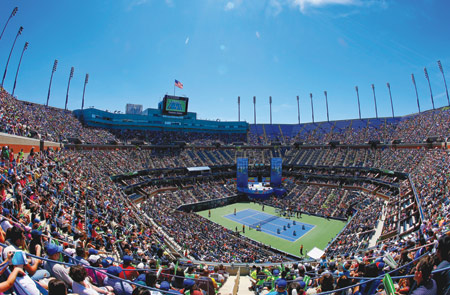
The 22,000-seat Arthur Ashe Stadium, the main venue for the Open.
The New York weather isn’t the only foreboding element to the 2013 United States Open as clouds above the Billie Jean King Tennis Center in Flushing Meadows threaten the final major tennis tournament of the year. Two of the game’s hardest hitters—defending women’s singles champion Serena Williams and her talented young American rival Sloane Stephens, who’d beaten Williams in an upset earlier in the year—are finishing their warm-up before a hotly anticipated match on the sport’s biggest stage.
This end-of-year rematch is CBS’ marquee contest for its annual Labor Day weekend of U.S. Open coverage, with the semifinals and finals slated for the next weekend. In one of many production trucks in a parking area behind the 22,000-seat Arthur Ashe Stadium, director Bob Fishman sits in front of a wall of television monitors showing him what the cameras are seeing all over the grounds as well as what tape machines have on deck. Producer (and DGA member) Bob Mansbach sits next to him, while producer David Winner is focused on the left side of the monitor wall watching the satellite stadium matches. Associate director Jason Ross sits behind Fishman as a kind of communication traffic cop, counting out of commercials and taped elements, and providing an extra eye on the bank of screens. Before Fishman can direct the match at hand, however, Williams and Stephens need to get out of their chairs. But instead they sit, no urgency in their demeanor.
“Is this some kind of psych move?” Mansbach wonders aloud. The players were already late coming out on the court, which caused Fishman to vamp with extra graphics and shots of the grounds. Even though player entrances are often strictly choreographed between the USTA and the broadcast network, timing snafus happen. It’s live television, after all.
Today, though, Fishman, a veteran of NFL and NCAA basketball who is helming his 26th U.S. Open, recognizes the unusual suspense at hand in this unexpected delay and cross-cuts a calm yet portentous series of images of the seated players on the sidelines; the experienced camera crew knows instinctively to push in ever tighter. Feeding off the tension of the shots, announcer Mary Carillo remarks over a close-up of Stephens that “there’s a lot going on” and the match hasn’t even started.
Once the set begins, Fishman utilizes the full arsenal of high-definition images on hand from more than 10 cameras—high, low, handheld, human-operated and robotic from every angle around the court—to exploit the energy and athleticism of the Williams and Stephens’ rallies, and the excitement of the crowd. When a flurry of punishing ground strokes goes long and elicits gasps from the stands, Fishman yells, “Big point!” It’s an alert to the camera operators to make sure their shots of the players, families and coaches, and the cheering fans will be in place for the reaction montage Fishman will cut to after the next point. Until then, however, Fishman wants the cameras on Williams and Stephens to stay full-body for the possibility of a slow-motion replay later.
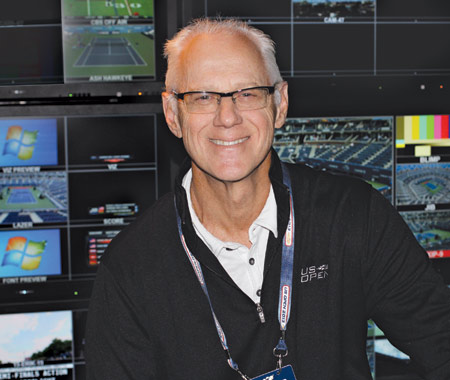 GRAND SLAM: Bob Fishman, who directed his 26th U.S. Open, takes every opportunity to humanize the action.
GRAND SLAM: Bob Fishman, who directed his 26th U.S. Open, takes every opportunity to humanize the action. Earlier, Fishman explained his thinking on this crucial visual aspect of sports directing: “In the middle of the point, everybody’s got to be head to toe. Once that serve happens, I don’t want any of [the cameras] on tight shots, waist shots, or close-ups. They’ve got to be covering like any sport, head to toe, for replays and reactions.”
Fishman takes advantage of every opportunity to humanize the stakes. Right after Stephens secures a crucial point in a tense game that could decide the set, he cuts rhythmically from Stephens to her mother (captured by a joystick-operated robotic camera trained on the players’ boxes), then to Williams walking back to the baseline, then to Williams’ mother, before returning to a reverse-angle shot of a focused Williams ready to return Stephens’ next serve. No replay now. But on the next point, Stephens misses a forehand wide, and Fishman opts for a replay angle aimed solely on her that perfectly captures the 20 year old’s disappointment at her shot.
Under Fishman’s direction, what the home audience sees between points is a mini-story of steeliness and worry, accomplishment and defeat, and it tells tennis fans everywhere, ‘If you thought the last exchange was eventful, just stay tuned.’ Colleagues of Fishman say this sense of timing is his bread and butter, and what makes the network’s Open coverage the most intimate feeling of all the televised major tennis championships.
“He’s one of the best in sports TV,” says Marcy Kempner, who worked as an AD for years with Fishman before joining the Tennis Channel. “He doesn’t miss anything. I had a bird’s-eye view of everything he was watching, and I would sometimes see something and think, ‘He should go to that,’ and he’d already be there. He sees it before I can even suggest it. Being able to take it all in and see what’s important—I think that’s talent.”
Fishman puts it this way: “The most important job [the camera crew] can have is to understand what I’m doing after a great point. That’s what separates what we do: the understanding of a great emotional moment; when you have time to cut around it in a way that lets the viewer enjoy the magnitude of it.”
In the 2012 men’s singles final, that moment was the seeming ocean of time before the point that would win Scottish phenom Andy Murray his first Grand Slam title. Fishman judiciously used dissolves between shots—including an unfurled Union Jack in the stands—to both honor and ratchet up the tension. Always a hard cut before the serve, though, in Fishman’s rulebook.
In this year’s men’s final between the top two players—Spaniard Rafael Nadal and Serbian Novak Djokovic—it was a great reaction shot of the Queen of Spain cupping her face with her hands after Djokovic won a long, drawn-out exchange. “I was watching her on the monitor to see if it was worth putting her into a tape machine,” Fishman said afterward. “She was stoic early on, but as people got into it, she got into it. I thought that was funny.”
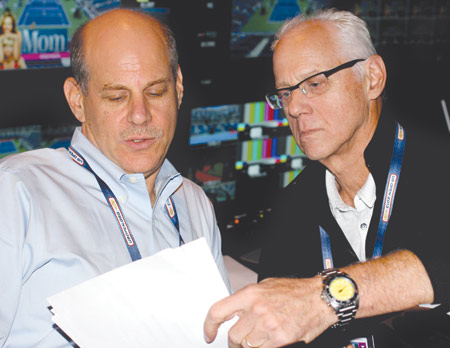
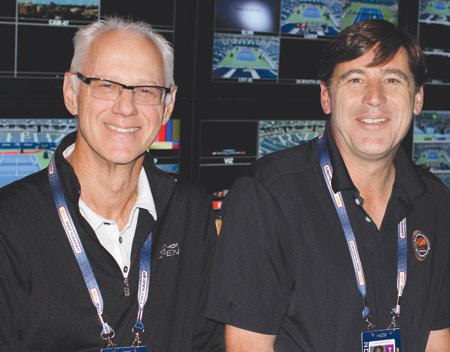
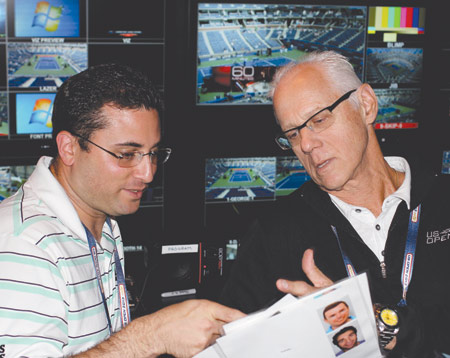
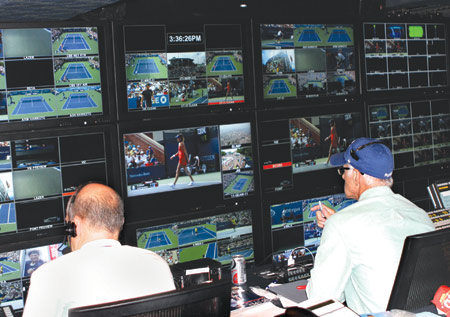
TEAMWORK: (above, top to bottom) Fishman with his longtime producer Bob Mansbach; world feed director Jim Cornell; and AD Jason Ross; Fishman (right) mans the board with Mansbach.
In 2009, it was the notorious meltdown Serena Williams had in the semifinals over a foot fault call, when she threatened a lineswoman, causing tournament officials to get involved. Suddenly an action flick had become an intense chamber drama acted in front of thousands. “In short, you’re drawn into a news event,” says Fishman. “It’s important then to show the relationship between Serena and the lineswoman, the chair umpire, and the other player who’s standing there thinking, ‘What the heck’s going on? Let’s play tennis.’ You know, in your head, this is going to be replayed over and over again around the world, so you have to be careful with your shots.”
For Fishman, directors covering tennis are only as good as the game in front of them. But when that match is great, he says, “then we can step up our game, because all the shots are there. It’s like a kid in a candy store.”
In the first week the store is stocked with not just shots, but matches themselves, which are going on all over the Billie Jean King Tennis Center grounds. They need to be covered, too, since CBS is responsible for the worldwide feed, manned by coordinating director Jim Cornell, who also directs studio updates and takes over for Fishman during meal breaks. Many of the international feed directors, working in separate trucks, are ADs getting a first shot at simple, unadorned play-by-play sports directing. “This is a great learning ground for the younger guys coming up who are not directors yet,” says Fishman. “If they only have four or five cameras to work with, it’s not a big deal for them.”
But on the main stages, Ashe and the neighboring Louis Armstrong Stadium, “it’s a very complex setup,” says Fishman, who will typically spend the days before the broadcast goes on the air walking the grounds, checking on matches and familiarizing himself with new players. “The first weekend is the hardest because you never know where you’re going. We’re serving many masters: we’re serving CBS, we’re serving international, hopping from court to court with different camera setups, announcers and microphones. Big events like the Final Four and the Super Bowl all take amazing effort. But the technical setup for this is extraordinarily difficult.”
Things settle down by the time CBS returns (ESPN and the Tennis Channel show the Open matches during the week) for the semifinals and finals, when the focus is one match at a time, and they’re all at Ashe. “The second weekend is far easier in terms of logistically doing it.”
For the finals weekend, Fishman will bring extra cameras into the stadium, including a moving-arm camera. “I need big, sweeping shots for the excitement of the arena,” he explains. “Because every time that crowd explodes, it’s my go-to shot.”
A tennis court may be an intimate rectangle, but in this massive bowl, with spectator rows extending high into the sky at sharp angles, the game can instantly feel gladiatorial in front of the often raucous New York crowd. “Tennis is more like boxing than any other sport,” says Mansbach. “It’s a head-to-head battle: who can wear the opponent down and eventually psychologically prevail. You get all kinds of weird things happening at the U.S. Open. It’s the culmination of the season, the final chapter of the story.”
CBS has been covering the U.S. Open since 1968, when tennis entered the “open era,” allowing amateurs and professionals to compete in the same tournaments. Since then, the network’s directors have covered plenty of tennis history as the game has morphed from quick points ended with a player rushing to the net at the first opportunity, to long rallies indicative of today’s more athletic players. But the rudiments of directing tennis for television haven’t changed much: a master shot from behind one baseline (because a side view would give everyone whiplash), followed by reaction shots. What has changed has been the way technology has enlivened the ability to dramatize the narrative of a match.
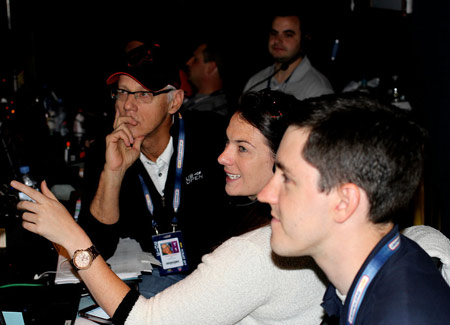
CALLING THE SHOTS: (above) Bob Fishman with specialty ADs Brian Jagoda (Eye Vision replays) and Alanna Campbell (teases and features); (below) Fishman with Alanna Campbell and Todd Keryc (tape AD for match replay packages).
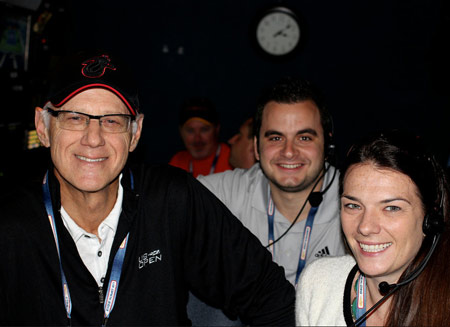
The biggest shift came with high-definition, which was first employed for the U.S. Open by CBS in 1999. Keeping track of a fast-moving ball in grainy standard definition was no longer an issue. “There was a time when directors took a lot of chances, intercutting in the middle of a point,” says Fishman. Risking a quick, post-stroke cut to a tighter shot of the far side player’s return, the ball might get lost. “I don’t think there’s a need to do that anymore with hi-def television. Everything is so clearly seen from a single angle.”
That angle is important, too. A high master shot is the standard, but there’s a low angle, directly behind the returning or serving player, that offers a unique perspective on just how much spin and height players can generate when they hit the ball. As popular as that angle is with tennis fans, however, it’s important for directors to cut to the high angle right after the serve or return for a very simple reason. “The lower you go, the net comes into play and it can block the far baseline, so now you don’t know if the ball’s in or out,” says Jim Cornell. “And that’s the important part. You want to be able to see that.”
Disputed line calls have always given tennis a dose of drama for directors to capitalize on, from the early days of heated players yelling at stoic linespeople and umpires to the current challenge system. The Hawk-Eye system, a proprietary technology now commonly used throughout the sport, triangulates a video feed from six high cameras aimed at the court to produce a three-dimensional representation of the ball’s trajectory, which is then shown in the arena to spectators and players and considered the final word. This computer-generated replay is now a separate feed in the truck that directors can cut to when a player challenges a linesperson’s call. A director, however, has to be fast: player challenges can be instantaneous, and Hawk-Eye waits for no one once the umpire sets it in motion.
“What you don’t want to happen is to realize, ‘Oh wait, they challenged, and you’ve missed the animation,” says associate director Ross. “That’s something I help with by paying attention to what’s going on on the court.”
Other advances have also added to the director’s toolbox. A bug in the corner of the screen now always gives the score, when in the early years—“the Dark Ages,” Fishman affectionately calls them—a viewer wouldn’t know who was playing, or what set it was, for long stretches at a time. Overlay technology is another device that allows ADs to create nifty replay graphics that can show how far players travel during a point. SwingVision, meanwhile, is the network’s dedicated high-speed camera, usually parked to the side of the baseline, that records at between 1,000 and 1,500 frames a second. “It’s how you get that incredible detail, muscles rippling, sweat flying through the air, the strings of the racquet going backwards with the compression of the ball,” says Fishman. “It blows my mind. I find myself getting distracted when we’re putting a replay on the air!”
The directors get a lot of help from tape ADs, too, who provide the various packages that promote upcoming matches and heighten the experience of watching a match. For the 2013 Open, feature producer Sarah Rinaldi shot and assembled artfully designed teases and openings; Brian Jagoda worked on replay graphics pertaining to player movement; Alanna Campbell re-cut the teases that come out of commercials; Bill Thayer—in conjunction with Winner—dealt with segments that would run in case of rain delays (a yearly Open issue), and Todd Keryc put together highlights packages. “They’re multi-faceted contributions to the show,” says Fishman. “It’s a big crew of really talented people.”
At the heart of it is the relationship between Fishman and Mansbach. “Those guys trust each other,” says Cornell. “I’ve heard Mansbach say many times, ‘Fish, it’s your thing, just cut your pictures. The scene is too great. No replays.’ As opposed to showing replay for the sake of showing replay. It’s just the good teamwork Bob and Bob have when the moment calls for it.”
Next year will be CBS’ last broadcast of the Open, after 47 years. Fishman acknowledges it will be bittersweet. “It’s business,” he says, “and I think if I had not experienced this in the past”—he directed both baseball and the Daytona 500 when they aired on CBS—“it would probably upset me a lot more than it’s going to. But I’ll miss the Open. This year, the last three or four days brought back to me how great this event can be.”
Fishman has many fond memories of the Open through the years, going back to when it was played on grass at Forest Hills in the ’70s and he was a CBS News AD freelancing as a tape AD on weekends for legendary sports producer Frank Chirkinian. (Fishman vividly recalls readying a tape highlight of famously ill-tempered Ilie Nastase calling a German opponent a “Nazi” for what he perceived to be fake cramping.) As Fishman graduated to directing, taking over for longtime sports director Bob Dailey, he took to heart the lessons learned from those pioneers.
“We’re in the tele-vision business,” says Fishman. “It’s about vision and pictures and storytelling. Frank was very adamant about that. It wasn’t that he taught me how to direct. I observed people like Dailey, Ted Nathanson and Tony Verna, but Frank was the one who hammered that home. He made announcers just be quiet. If you notice, CBS announcers never talk over a point. Because there’s nothing you can say that will embellish a great picture that tells the story of what’s happening in front of you.”